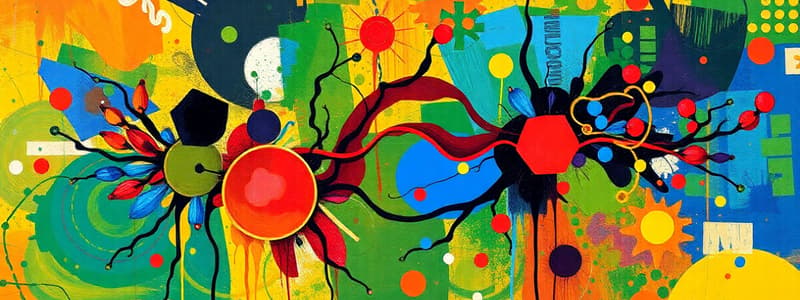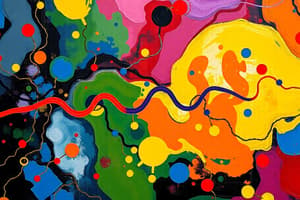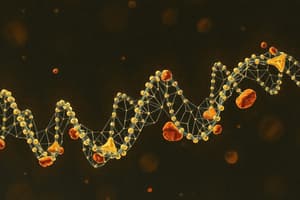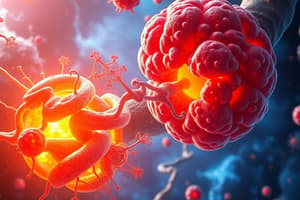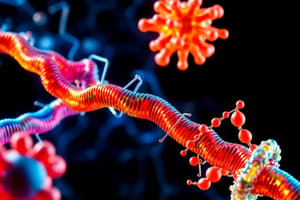Podcast
Questions and Answers
How many protons are pumped by Complex III for every two electrons transferred?
How many protons are pumped by Complex III for every two electrons transferred?
- 8 protons
- 4 protons (correct)
- 2 protons
- 6 protons
Which of the following statements about cytochromes is incorrect?
Which of the following statements about cytochromes is incorrect?
- Cytochromes can be membrane-bound or diffusible.
- Heme is a type of protein. (correct)
- Cytochromes contain a heme group.
- Cytochromes can function as single electron carriers.
What is the primary function of cytochrome oxidase (Complex IV)?
What is the primary function of cytochrome oxidase (Complex IV)?
- Transfer electrons from NADH to oxygen
- Pump protons into the intermembrane space
- Transfer electrons from cytochrome c to oxygen (correct)
- Reduce oxygen to hydrogen peroxide
Which of the following best describes the electron transfer process in cytochrome oxidase?
Which of the following best describes the electron transfer process in cytochrome oxidase?
Which of the following intermediates may remain tightly bound during the incomplete reduction in Complex IV?
Which of the following intermediates may remain tightly bound during the incomplete reduction in Complex IV?
What is the primary role of the proton gradient established across the inner membrane of the mitochondria?
What is the primary role of the proton gradient established across the inner membrane of the mitochondria?
How many ATP molecules are synthesized for every two electrons donated by NADH?
How many ATP molecules are synthesized for every two electrons donated by NADH?
Which shuttle system is utilized for NADH generated in the cytoplasm specifically by skeletal muscle and brain tissues?
Which shuttle system is utilized for NADH generated in the cytoplasm specifically by skeletal muscle and brain tissues?
What is the net yield of ATP from the complete oxidation of one glucose molecule, considering all pathways?
What is the net yield of ATP from the complete oxidation of one glucose molecule, considering all pathways?
Which of the following complexes does not directly transport protons during electron transport?
Which of the following complexes does not directly transport protons during electron transport?
What components contribute to the electrochemical energy stored in the proton-motive force?
What components contribute to the electrochemical energy stored in the proton-motive force?
Which of the following statements about FADH2 is correct in the context of ATP synthesis?
Which of the following statements about FADH2 is correct in the context of ATP synthesis?
In which location within a mitochondrion does ATP synthesis occur through ATP synthase?
In which location within a mitochondrion does ATP synthesis occur through ATP synthase?
What is the primary function of the electron transport chain (ETC) in mitochondria?
What is the primary function of the electron transport chain (ETC) in mitochondria?
Which complex in the electron transport chain directly accepts NADH?
Which complex in the electron transport chain directly accepts NADH?
How do FADH2 and NADH differ in their role in the electron transport chain?
How do FADH2 and NADH differ in their role in the electron transport chain?
What is the result of the transfer of electrons through the electron transport chain?
What is the result of the transfer of electrons through the electron transport chain?
What is the role of ATP synthase in oxidative phosphorylation?
What is the role of ATP synthase in oxidative phosphorylation?
Which of the following statements about redox potentials in the electron transport chain is correct?
Which of the following statements about redox potentials in the electron transport chain is correct?
Which substance serves as the final electron acceptor in the electron transport chain?
Which substance serves as the final electron acceptor in the electron transport chain?
What is the approximate energy stored in the reduced cofactors after the oxidation of 1 mole of glucose?
What is the approximate energy stored in the reduced cofactors after the oxidation of 1 mole of glucose?
Flashcards
Oxidative Phosphorylation
Oxidative Phosphorylation
The process in cells that generates most of the ATP, utilizing the energy stored in reduced electron carriers (NADH and FADH2) from glycolysis and the citric acid cycle.
Complex III function
Complex III function
Pumps 4 protons per 2 electrons transferred, using iron-sulfur proteins and cytochromes.
Electron Transport Chain (ETC)
Electron Transport Chain (ETC)
A series of protein complexes in the inner mitochondrial membrane that transfer electrons from NADH and FADH2 to oxygen, generating a proton gradient.
Cytochrome
Cytochrome
Signup and view all the flashcards
ATP Synthase
ATP Synthase
Signup and view all the flashcards
Complex IV function
Complex IV function
Signup and view all the flashcards
Q cycle
Q cycle
Signup and view all the flashcards
NADH & FADH2
NADH & FADH2
Signup and view all the flashcards
Electron Donors/Acceptors (ETC)
Electron Donors/Acceptors (ETC)
Signup and view all the flashcards
Cytochrome c
Cytochrome c
Signup and view all the flashcards
Proton Gradient
Proton Gradient
Signup and view all the flashcards
Substrate-level phosphorylation
Substrate-level phosphorylation
Signup and view all the flashcards
Cytosolic NADH Shuttle Systems
Cytosolic NADH Shuttle Systems
Signup and view all the flashcards
Electron Transport Chain (ETC) location
Electron Transport Chain (ETC) location
Signup and view all the flashcards
Proton motive force
Proton motive force
Signup and view all the flashcards
ATP Synthase function
ATP Synthase function
Signup and view all the flashcards
NADH vs. FADH2 ATP yield
NADH vs. FADH2 ATP yield
Signup and view all the flashcards
Glycerol 3-phosphate shuttle
Glycerol 3-phosphate shuttle
Signup and view all the flashcards
Malate-aspartate shuttle
Malate-aspartate shuttle
Signup and view all the flashcards
Aerobic glucose oxidation ATP yield
Aerobic glucose oxidation ATP yield
Signup and view all the flashcards
Inner mitochondrial membrane permeability
Inner mitochondrial membrane permeability
Signup and view all the flashcards
Study Notes
Oxidative Phosphorylation Learning Objectives
- Explain the significance of oxidative phosphorylation
- Understand electron flow and proton pumping in the electron transport chain (ETC) complexes
- Recognize initial and final electron donors/acceptors in each ETC complex
- Explain ATP formation by ATP synthase
- Recognize two different shuttle systems for cytosolic NADH to enter the ETC
Oxidative Phosphorylation Details
- Glycolysis and the TCA cycle produce very little ATP directly (substrate-level phosphorylation)
- Glycolysis: 2 ATPs; TCA cycle: 2 ATPs per glucose
- Remaining energy stored in reduced cofactors (10 NADH and 2 FADH2 per glucose)
- Overall reaction: C₆H₁₂O₆ + 6O₂ → 6CO₂ + 6H₂O (ΔG°' = -2870 kcal/mol)
- Oxidation of reduced co-factors releases energy:
- NADH + H⁺ + 1/2 O₂ → NAD⁺ + H₂O (ΔG°' = -220 kcal/mol)
- FADH₂ + 1/2 O₂ → FAD + H₂O (ΔG°' = -182 kcal/mol)
- Oxidation of one glucose mole stores 2564 kJ of energy (about 90% of total under standard conditions)
NAD+/NADH and NADP+/NADPH
- Diffusible 2-electron carriers
- Accept or donate one hydride ion (H⁻) = (1 proton + 2 electrons)
FAD/FADH₂ and FMN/FMNH₂
- Bound to enzymes as prosthetic groups
- Accept or donate one H⁺ + one electron at a time
Oxidation of Fatty Acids and Amino Acids
- Oxidation of fatty acids and some amino acids produce acetyl-CoA and NADH/FADH₂
The Mitochondrion
- Aerobic oxidation of biomolecules occurs within the mitochondrion
- Structure includes outer membrane, inner membrane, cristae, matrix, and intermembrane space
Electron Transport Chain (ETC) in Mitochondria
- Electron flow is favorable from donors with lower reduction potential (more negative E values) to acceptors with higher reduction potential.
- ETC consists of four integral membrane protein complexes (I-IV)
Summary of Electron Flow in Inner Membrane
- Diagram showing the flow of electrons from NADH to oxygen through complexes I, II, III, and IV. The table shows the standard reduction potentials for each complex's substrates.
Standard Reduction Potentials
- Table of standard reduction potentials for various ETC components and complexes
NADH Dehydrogenase (Complex I)
- Cofactors: FMN, iron-sulfur clusters
- Transfers electrons from NADH to ubiquinone (Q)
- Ubiquinol (QH₂) carries electrons through the inner membrane to Complex III
- Overall reaction: NADH + H⁺ + Q → NAD⁺ + QH₂
- Proton pumping occurs, moving protons from the matrix to the intermembrane space
FMN
- Protein-bound co-factor
- Accepts or donates one H⁺ + one electron at a time
- Exists in oxidized (FMN), radical (FMNH•), reduced (FMNH₂) forms
Iron-Sulfur (Fe-S) Clusters
- Single electron carriers
- Each iron (Fe) is coordinated by four sulfur atoms (S)
- Four cysteine residues from a protein contribute to the cluster
- Can have a single Fe coordinated by four cysteine residues
Q (or CoQ)/QH₂
- Diffusible through inner membrane
- Accepts or donates one electron and one proton at a time
Succinate Dehydrogenase (Complex II)
- Only membrane-bound enzyme in the TCA cycle
- Contains internal electron transfer cofactors (FAD and Fe-S centers)
- QH₂ carries electrons through inner membrane to Complex III
- No proton pumping occurs
Cytochrome bc₁ Complex (Complex III)
- Electron carriers: Fe-S centers, cytochrome b and cytochrome c₁
- Transfers electrons from ubiquinol (QH₂) to cytochrome c
- Complex III pumps four protons per two electrons transferred
Cytochromes
- Proteins containing a heme group (which coordinates an Fe(II/III) atom)
- Heme a: within complex IV
- Heme b: within complex III
- Heme c: within complexes III and IV
The Q Cycle in Complex III
- Diagram and description of the Q cycle, including rounds 1 and 2.
- The cycle transports electrons and pumps protons
Cytochrome Oxidase (Complex IV)
- Electron carriers include two copper ions and two heme A groups (cytochrome a proteins).
- Transfers electrons from cytochrome c to oxygen.
- Four cytochromes c (reduced) + O₂ 4 cytochrome c (oxidized) + 2 H₂O
- Incompletely reduced intermediates (e.g. peroxide, hydroxyl radicals) remain bound until complete reduction to water
Electron Transport and Proton Pumps
- Overall schematic showing electron flow through complexes I, II, III, and IV, alongside proton pumping.
Proton Gradient
- Protein gradient across the inner membrane
- Energy released when protons flow down gradient drives ATP synthesis
ATP Synthesis by ATP Synthase
- ATP synthase (FoF₁ complex) is in inner membrane.
- Protons flow through Fo unit down the gradient, driving ATP synthesis by the F₁ unit (ATPase) from ADP and Pi
- For every 2 electrons donated by NADH, 2.5 ATPs are synthesized. For every 2 electrons donated by FADH₂, 1.5 ATPs are synthesized.
Shuttle Systems for NADH Generated in Cytoplasm
- Inner mitochondrial membrane is impermeable to NADH.
- Glycerol 3-phosphate shuttle: prevalent in skeletal muscle and brain
- Malate-aspartate shuttle: prevalent in liver, kidney, and heart
- These shuttles ferry reducing equivalents (NADH equivalents) across the membrane.
Net Profit of Aerobic Metabolism
- Summary of ATP yield from complete glucose oxidation (30-32 ATPs) - accounting for different NADH shuttle systems.
Studying That Suits You
Use AI to generate personalized quizzes and flashcards to suit your learning preferences.
